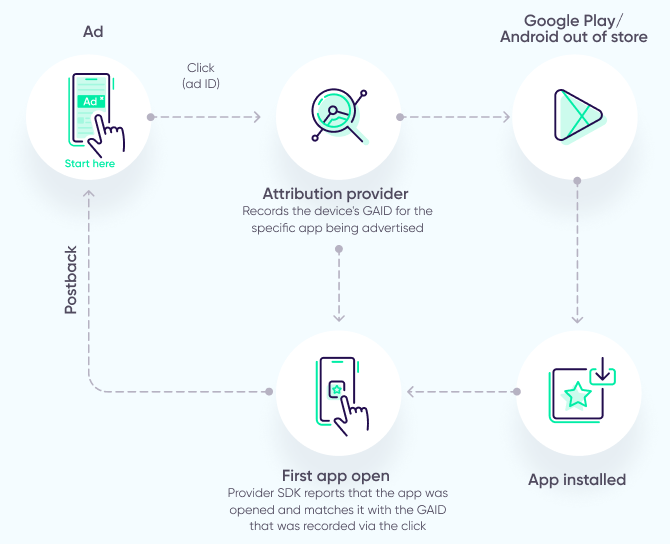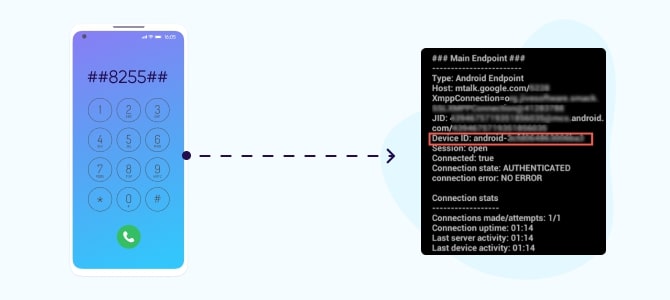What is a device ID in mobile technology?
A device ID is a unique identifier assigned to a mobile device, used for tracking and analyzing app installations and in-app activities without revealing any personal user information.
Try searching for
A device ID is a unique, anonymized string of numbers and letters that identifies a single mobile device: a smartphone, a tablet, or a wearable such as a smart watch.
A device ID is a unique identifier linked to a particular mobile device. It’s anonymous, because it doesn’t contain any personally identifiable information (PII) about the user, such as their name, email, address, or credit card number.
In the past, any app installed on the device could retrieve the device ID, allowing marketers and developers to measure campaign and in-app activities without access to users’ personal information.
However, that changed with the introduction of Apple’s App Tracking Transparency (ATT) framework, which now requires app owners to get permission to access an Apple user’s device ID. This shift towards a privacy-first world brings challenges for marketers looking to measure and optimize their campaigns. With less data available on individual users or devices, aggregated data is becoming increasingly important — we’ll explore this in more detail later.
There are two main types of device IDs: Apple uses the ID for Advertisers (IDFA) and Android uses the Google Advertiser ID (GAID). They essentially work in the same way to connect a user’s actions with an ad campaign, an install, or in-app activities. The key difference today is that for Apple devices, marketers and app owners can only access the IDFA if the user has opted in.
The Apple IDFA comprises eight characters, a dash, and then three sets of four characters. All letters are upper case. Here’s an example:

The GAID follows the same format but uses lower-case letters, as follows:

The device ID is an important tool for attributing marketing activities and mapping the user journey — from ad engagement, through install, to in-app events. Here’s how it’s used:
Marketers can use a technique called deterministic attribution to track a user’s actions across multiple channels and interactions. Matching the device ID to each interaction provides a detailed and highly accurate picture of user behavior.
The device ID can be retrieved by any installed app, once it’s launched for the first time. (As mentioned above, this is only possible on Apple devices if the user has consented to tracking.)

After the initial launch, the device ID can be used for attribution purposes by measuring the install and tying it to previous activity.
Let’s take attributing an app install as an example.
Finding your device ID is straightforward, whether you have an Android or an Apple device.
On Android, open your phone keypad and enter *#*#8255#*#*. As soon as you type the last digit the GTalk service monitor device will pop up where you’ll be able to see your device ID.

For an Apple device, you can download “My device IDFA by Appsflyer” from the app store to discover the device ID.
Since the release of iOS 14, with its increased focus on user privacy, Apple has required apps to ask users to opt in to sharing their IDFA.
Previously, Apple users had to opt out of tracking by enabling LAT (Limited Ad Tracking), which caused their IDFA to display as a string of zeros. The current ATT, on the other hand, means users can choose to opt in.
The proportion of users who do opt in to tracking varies by app type, but 2022 figures show an average global opt-in rate of 46%. That leaves a significant proportion of devices that can’t be tracked for marketing purposes. But it’s not game over for marketers: new tech solutions make it possible to measure campaign success without compromising user privacy.
With device-level data now in shorter supply, marketers are turning to aggregated data to inform their iOS campaigns. With this approach, data is consolidated across groups of users, revealing broader trends rather than individual actions.
As marketers adapt to the privacy-first landscape, various alternative methods have emerged to help attribute marketing activities.
This is Apple’s privacy-centric framework that aims to measure app installs and campaign performance without compromising user anonymity.
While SKAdNetwork offers a solution based on aggregated campaign data, it comes with various limitations and complexities that marketers need to navigate. For example, postbacks (reports on activity) are delayed and there’s a limited number of them, focusing on the early stages of the user journey. This makes it harder to measure lifetime value or re-engagement activity.
Working with a mobile measurement partner (MMP) can help you get more from SKAdNetwork: they’ll handle the data securely and provide in-depth analysis and insights.
Machine learning algorithms can help us understand trends in user behavior, so that we can predict how valuable these users might be over time, and whether a campaign is likely to be successful.
Probabilistic modeling can make predictions based on aggregated data, revealing behavioral trends while protecting user privacy. Combining these techniques with machine learning is a powerful and accurate way to understand user behavior and predict campaign success early on.
Incrementality testing uses a control and test mechanism to show the true value of your marketing efforts. In particular, it can tell you what portion of business was the result of a campaign, and what would have occurred organically.
This additional layer of intelligence can give you greater confidence in the success of your campaign.
Web-to-app flows take a user from a webpage to a corresponding app.
In the context of iOS 14.5, web-to-app flows help marketers connect the dots without the use of the IDFA. This is because the journey includes ad networks and owned media, so first-party data can be used to optimize the experience.
A device ID is a unique identifier assigned to a mobile device, used for tracking and analyzing app installations and in-app activities without revealing any personal user information.
Apple devices use the ID for Advertisers (IDFA), and Android devices use the Google Advertiser ID (GAID). The main difference now is that Apple requires user consent to access IDFA, while Android devices provide GAID access more freely.
Device IDs are crucial for marketers as they enable deterministic attribution, providing an accurate picture of user behavior. They also help with personalized advertising, user segmentation, and detailed analysis of app engagement, all while maintaining user privacy.
Privacy enhancements have made it more challenging for marketers to collect comprehensive user data for targeted advertising. This is particularly true on iOS, where the App Tracking Transparency (ATT) framework requires app users’ consent to share their device ID.
Marketers can use aggregated data, SKAdNetwork for app install attribution, machine learning for predictive analytics, incrementality testing for measuring campaign effectiveness, and web-to-app flows to navigate the privacy-first landscape effectively.
While device IDs used to be central to measurement and optimization in the mobile ecosystem, the shift to a privacy-first landscape has pushed app marketers to explore new solutions.
